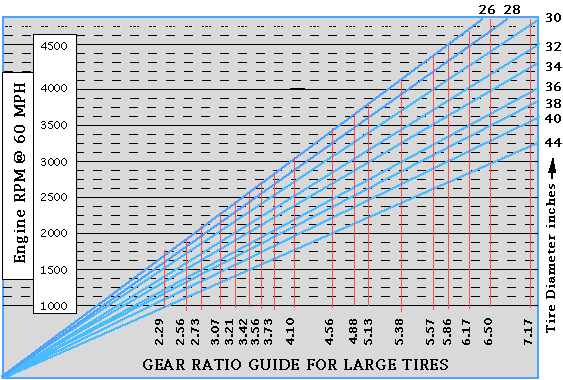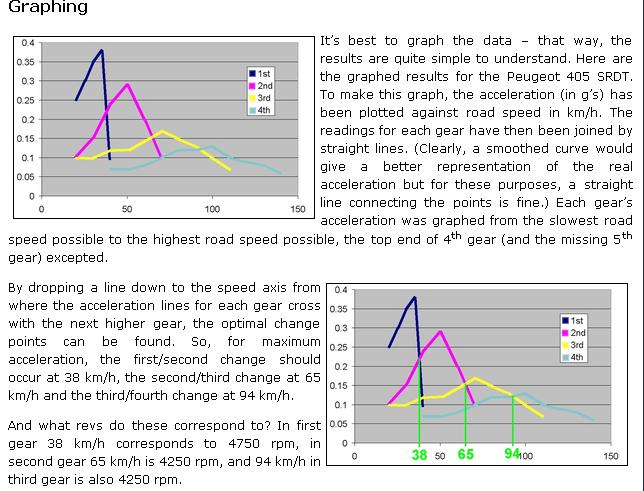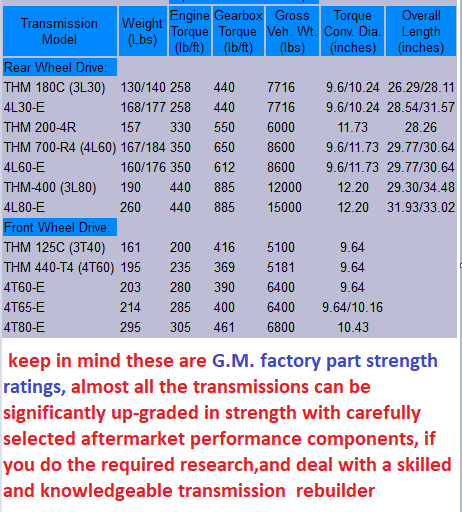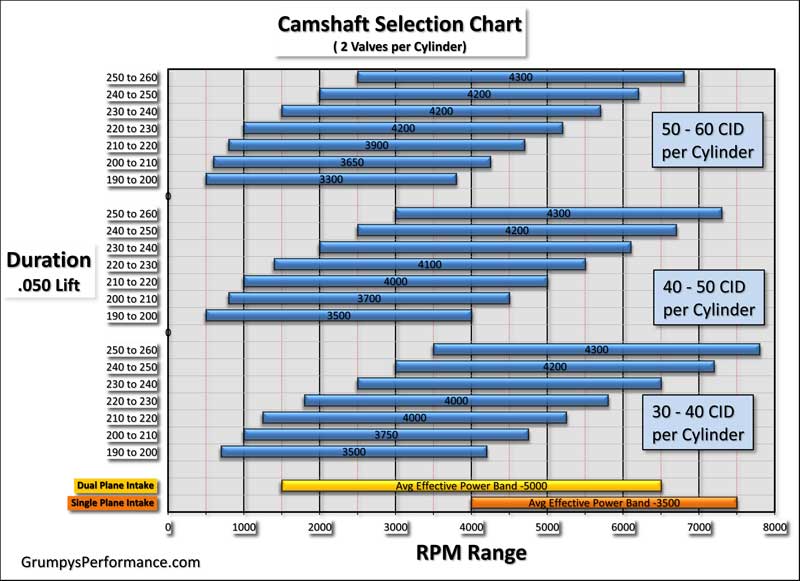you really should read all the links and sub-links below to maximize your understanding of the concepts, in the thread
READ THE LINKS AND SUB LINKS

 www.randysworldwide.com
www.randysworldwide.com
http://garage.grumpysperformance.co...hing-the-drive-train-to-the-engine-combo.741/
http://www.wallaceracing.com/calc-rpm-drop-shift.php
http://www.zealautowerks.com/transcalc.php
http://garage.grumpysperformance.co...ear-axles-and-differentials.11848/#post-99450
https://www.silveradosierra.com/threads/all-in-one-final-drive-gear-calculator.616410/
http://www.grimmjeeper.com/gears.html
http://garage.grumpysperformance.co...late-gear-ratios-and-when-to-shift-calcs.555/
http://garage.grumpysperformance.com/index.php?threads/tires-and-tire-compounds.1676/#post-63907
http://garage.grumpysperformance.co...asonably-fast-in-street-trim.3404/#post-33377


do a few calculations, think about the rpm band
YOUR engine makes its best power in,
and YOUR tire diameter
and YOUR cars weight
and YOUR rear gearing,
and YOUR trans GEARING
as a general rule if your looking for brisk street performance,
(especially with an over drive transmission)
youll want the transmission first gear . multiplied times the rear gear ratio to fall in the 10:1-10.6:1 range
and youll want the engine to cruse at 70 mph in the lower end of the engines effective torque curve
if we assume your looking at maximizing a performance cars acceleration while maintaining a reasonable cruise rpm for mileage, and you have a tire diam range of between 26-29" tall as, most muscle cars have, you can just find the ratio that multiplied times your transmissions first gear ratio falls in the 10:1-10.6:1 range and you'll find it works out rather well, especially with the OVER DRIVE TOP GEAR TRANSMISSIONS
if you don,t have an over drive transmission most guys just select the gear ratio that when matched to their tire diam. that will have the engine rpm range fall in the 2400rpm-2600rpm, or the lower edge of the engine torque curve, range at 70mph
Gear comparisons for 700R4 vs. other GM Transmissions:
.............................1st.......2nd....3rd....4th
Power Glide..............1.76......1.0
TH350 .....................2.52.....1.52....1.0
TH400......................2.48.....1.48....1.0
700-R4/4L60..............3.06.....1.63....1.0.....70
200-R4.....................2.74.....1.57....1.0.....67
4L80E......................2.48.....1.48....1.0.....75
EXAMPLE
I know some people would rather gargle flaming broken glass than use info in links and sub-links but theres a great deal of useful info you can use
CALCULATORS CAN BE USEFUL
http://www.vibratesoftware.com/
http://www.blocklayer.com/Rpm-GearEng.aspx
http://glennmessersmith.com/shiftpt.html
http://www.5speeds.com/ratios.html
http://www.f-body.org/gears/
http://garage.grumpysperformance.co...electing-a-torque-converter-stall-speed.1715/
http://purplesagetradingpost.com/sumner ... index.html
http://www.jegs.com/p/Richmond-Gear/Ric ... 3/10002/-1
http://vexer.com/automotive-tools/1-4-mile-ET-HP-MPH-calculator
http://tire-size-conversion.com/tire-height-calculator/
http://www.summitracing.com/expertadvic ... calculator
http://www.wallaceracing.com/gearcalc.php
http://www.wallaceracing.com/gear-speed.php
http://www.offroaders.com/info/tech-cor ... ph-rpm.htm
http://www.prosystemsracing.com/calculate.html
http://www.fatboyraceworks.com/gears/
http://garage.grumpysperformance.com/index.php?threads/matching-the-combo.11020/#post-48707
http://www.wallaceracing.com/RPM%20Drop ... ulator.php
http://www.wallaceracing.com/gear-speed.php
http://www.wallaceracing.com/gearcalc.php
http://wallaceracing.com/Calculators.htm
http://robrobinette.com/et.htm
http://tire-size-conversion.com/tire-size-chart/


you should ideally select a cam , tire diam. converter stall speed and differential gearing, THE CARS WEIGHT AND,AT WHAT RPM THE TRANSMISSION WILL SHIFT TO THE NEXT GEAR UNDER WOT RACING CONDITIONS, that put the engine rpm MOST EFFECTIVELY MATCHED TOO<or in your engines most effective power range, so your maximizing the torque in your power curve about 90% of the time
if your first gear ratio in your 4l80e transmission were to be a 2.48:1 you divide 10.25/2.48 and you find the closest ratio is a 4.11:1, if your more concerned with mileage than brute acceleration ,you should drop back to a 3.73:1 or a compromise 3.90:1 ratio
you get the advantage of reasonably low gears and highway drive ability if you install the correct over drive transmission, and reasonably low rear gearing, everything's a compromise but its easily possible to get a decent combo, lets say you want want to cruise at 2500-2800rpm and a top speed in excess of 120mph at a reasonable 6000rpm and a good launch with torque, and you multiplication that low gears provide, your running lets assume a 24"-26" tire
you want the first gear ratio times the rear gear ratio to fall in the 10:1-11:1 range


lets assume your dealing with a th400 and 2.73 rear gears you fall into the 2.48/2.73=6.77:1 range killing fast acceleration
swap to a 5.13 rear gear with that 2.48 th400 trans gear and you fall in the 12.73 range killing cruising speed, as well as top speed, which would be around 80mph in top gear.

but lets swap that 5.13 rear gear into a car with a 4l80e TRANSMISSION with its overdrive gearing, its 0.75 brings you a top speed of near 117mph , and a launch ratio of 12.7:1, not bad with big sticky slicks on a light weight car, but not ideal on the street
now lets try to get both a great top speed and a great launch plus a decent cruise rpm,
with a 26" tire
(obviously youll need to measure and calculate your particular needs)
we start with the 4l80e trans first gear divided into 10:1-11:1 and find a 4.11:1-4.33:1 ratio is a great choice, a 4.11:1-4.33:1 ratio gives you a 140mph-150mph theoretical top speed, and a cruise speed near 65mph, a 3.73-3.90:1 rear gear would probably be better on a car used mostly for cruising as it will drop the cruise rpm several hundred rpm



trans gearing
http://vexer.com/automotive-tools/speed-rpm-calculator
http://www.vibratesoftware.com/
http://www.stl-vettes.com/65Vette/Trans ... earing.htm
http://purplesagetradingpost.com/sumner ... index.html
http://purplesagetradingpost.com/sumner ... index.html
http://www.drivetrain.com/autotranscrossref.html
http://www.bgsoflex.com/rpmmph.html
http://700r4.com/speedoCalc/rpmgearscalc.shtml
http://www.chevyhiperformance.com/techa ... index.html
http://www.tciauto.com/tc/trans-dim
http://www.tciauto.com/tc/gear-ratios
impalla65ss posted this link below
This is pretty extensive. Everyone will learn a lot from it.
get this excel-file downloaded and play with it <<<<<CLICK ON LINK
youll find what you want here
https://www.google.com/search?q=how%2Bt ... ar%2Bratio
http://www.btc-bci.com/~billben/reargear.htm
http://www.thirdgen.org/calculations
http://www.geocities.com/z_design_studi ... zx_tt.html
http://www.datsuns.com/Tech/whentoshift.htm
FIRST, THANK YOU IFATGMC!!!
THATS VERY USEFUL, IF YOU DON,T MIND ILL MAKE THIS A STICKY :grin:
http://purplesagetradingpost.com/sumner/bvillecar/bville-spreadsheet-index.html
HERES OTHER INFO LINKS
http://www.xracingsports.com/tirecalc.html
http://www.secondstrike.com/Technical/GearCalc.asp
http://www.5speedtransmissions.com/calculators.html
http://www.geocities.com/z_design_studi ... zx_tt.html
http://www.datsuns.com/Tech/whentoshift.htm
http://www.corvetteactioncenter.com/tec ... scalc.html
http://www.wallaceracing.com/reargear.htm
http://users.erols.com/srweiss/calcmph.htm
http://www.tciauto.com/Products/TechInf ... tors.asp#8
http://www.grimmjeeper.com/gears.html
http://users.erols.com/srweiss/calcrpm.htm
http://users.erols.com/srweiss/calcrgr.htm
http://users.erols.com/srweiss/transc.htm#tabtop
http://users.erols.com/srweiss/transc.htm#Auto
http://www.gmtuners.com/gmtransinfo.htm
heres some calculators to play with
http://robrobinette.com/et.htm
http://www.wallaceracing.com/et-hp-mph.php
http://www.competitiondiesel.com/Phil/bg/
http://www.stealth316.com/2-calc-hp-et-mph.htm
http://drag-zone.com/calculators.html#1
http://www.leeracingteam.com/et.htm
if your looking for a 3.73-4.11 rear gear for your corvette,and can,t find a 4.11 gear,the reason is that the highest COMMON gear ratio is 3.73:1 in that differential for that C4 corvette, but heres a link, btw you do realize that 4.09, 4.10, 4.11:1 rear gears are all the same exact SAME ratio and the difference is in how they were calculated
the RATIO IS CALCULATED BY COUNTING THE NUMBER gear teeth on the RING GEAR are divided by the NUMBER OF TEETH ON THE PINION GEAR

btw, for anyone reading thru this thread,
if you've got a transmission without an over drive top gear ratio like a th400, th350, etc I would consider ,STRONGLY CONSIDER something in the 3.07-3.31 rear gear ratio range, if you have an over drive top gear, like a 700r4, 4l80e, 200r4 the same criteria apply but youll find , a 3.54.-3.90:1 rear gear as a good choice
remember this is for effectively gearing a mixed performance/transportation street/strip car, combo and
Id suggest gearing the car so your drive train gearing falls in a range where the transmissions FIRST GEAR x REAR GEAR ratio fall close to being in the 10:1-to-11:1 range and if your engines spinning at 6000rpm in top o.d. gear places the car speed no higher than 135 mph, the closer you can get the gearing to fall in that gearing range the more responsive most cars will be,get the rear gear ratio low enough that the rear gear ratio times first gear is over 11:1 and your first two gears become far less useful without major suspension mods and SLICKS, and truthfully, how many times do you need to exceed 135mph?
http://www.datsuns.com/Tech/whentoshift.htm
http://www.welltall.com/ymc/discovery/car/shiftpt.html
http://www.bgsoflex.com/shifter.html
http://autospeed.com/cms/title_Finding- ... ticle.html

READ THE LINKS AND SUB LINKS
Transmission Ratio RPM Calculator | RANDYS Worldwide
By entering your R&P Ratio, Tire Height, Speed (mph), and Transmission Ratio, you can quickly calculate RPM
http://garage.grumpysperformance.co...hing-the-drive-train-to-the-engine-combo.741/
http://www.wallaceracing.com/calc-rpm-drop-shift.php
http://www.zealautowerks.com/transcalc.php
http://garage.grumpysperformance.co...ear-axles-and-differentials.11848/#post-99450
https://www.silveradosierra.com/threads/all-in-one-final-drive-gear-calculator.616410/
http://www.grimmjeeper.com/gears.html
http://garage.grumpysperformance.co...late-gear-ratios-and-when-to-shift-calcs.555/
http://garage.grumpysperformance.com/index.php?threads/tires-and-tire-compounds.1676/#post-63907
http://garage.grumpysperformance.co...asonably-fast-in-street-trim.3404/#post-33377

do a few calculations, think about the rpm band
YOUR engine makes its best power in,
and YOUR tire diameter
and YOUR cars weight
and YOUR rear gearing,
and YOUR trans GEARING
as a general rule if your looking for brisk street performance,
(especially with an over drive transmission)
youll want the transmission first gear . multiplied times the rear gear ratio to fall in the 10:1-10.6:1 range
and youll want the engine to cruse at 70 mph in the lower end of the engines effective torque curve
if we assume your looking at maximizing a performance cars acceleration while maintaining a reasonable cruise rpm for mileage, and you have a tire diam range of between 26-29" tall as, most muscle cars have, you can just find the ratio that multiplied times your transmissions first gear ratio falls in the 10:1-10.6:1 range and you'll find it works out rather well, especially with the OVER DRIVE TOP GEAR TRANSMISSIONS
if you don,t have an over drive transmission most guys just select the gear ratio that when matched to their tire diam. that will have the engine rpm range fall in the 2400rpm-2600rpm, or the lower edge of the engine torque curve, range at 70mph
Gear comparisons for 700R4 vs. other GM Transmissions:
.............................1st.......2nd....3rd....4th
Power Glide..............1.76......1.0
TH350 .....................2.52.....1.52....1.0
TH400......................2.48.....1.48....1.0
700-R4/4L60..............3.06.....1.63....1.0.....70
200-R4.....................2.74.....1.57....1.0.....67
4L80E......................2.48.....1.48....1.0.....75
EXAMPLE
I know some people would rather gargle flaming broken glass than use info in links and sub-links but theres a great deal of useful info you can use
CALCULATORS CAN BE USEFUL
http://www.vibratesoftware.com/
http://www.blocklayer.com/Rpm-GearEng.aspx
http://glennmessersmith.com/shiftpt.html
http://www.5speeds.com/ratios.html
http://www.f-body.org/gears/
http://garage.grumpysperformance.co...electing-a-torque-converter-stall-speed.1715/
http://purplesagetradingpost.com/sumner ... index.html
http://www.jegs.com/p/Richmond-Gear/Ric ... 3/10002/-1
http://vexer.com/automotive-tools/1-4-mile-ET-HP-MPH-calculator
http://tire-size-conversion.com/tire-height-calculator/
http://www.summitracing.com/expertadvic ... calculator
http://www.wallaceracing.com/gearcalc.php
http://www.wallaceracing.com/gear-speed.php
http://www.offroaders.com/info/tech-cor ... ph-rpm.htm
http://www.prosystemsracing.com/calculate.html
http://www.fatboyraceworks.com/gears/
http://garage.grumpysperformance.com/index.php?threads/matching-the-combo.11020/#post-48707
http://www.wallaceracing.com/RPM%20Drop ... ulator.php
http://www.wallaceracing.com/gear-speed.php
http://www.wallaceracing.com/gearcalc.php
http://wallaceracing.com/Calculators.htm
http://robrobinette.com/et.htm
http://tire-size-conversion.com/tire-size-chart/


you should ideally select a cam , tire diam. converter stall speed and differential gearing, THE CARS WEIGHT AND,AT WHAT RPM THE TRANSMISSION WILL SHIFT TO THE NEXT GEAR UNDER WOT RACING CONDITIONS, that put the engine rpm MOST EFFECTIVELY MATCHED TOO<or in your engines most effective power range, so your maximizing the torque in your power curve about 90% of the time
if your first gear ratio in your 4l80e transmission were to be a 2.48:1 you divide 10.25/2.48 and you find the closest ratio is a 4.11:1, if your more concerned with mileage than brute acceleration ,you should drop back to a 3.73:1 or a compromise 3.90:1 ratio
you get the advantage of reasonably low gears and highway drive ability if you install the correct over drive transmission, and reasonably low rear gearing, everything's a compromise but its easily possible to get a decent combo, lets say you want want to cruise at 2500-2800rpm and a top speed in excess of 120mph at a reasonable 6000rpm and a good launch with torque, and you multiplication that low gears provide, your running lets assume a 24"-26" tire
you want the first gear ratio times the rear gear ratio to fall in the 10:1-11:1 range


lets assume your dealing with a th400 and 2.73 rear gears you fall into the 2.48/2.73=6.77:1 range killing fast acceleration
swap to a 5.13 rear gear with that 2.48 th400 trans gear and you fall in the 12.73 range killing cruising speed, as well as top speed, which would be around 80mph in top gear.

but lets swap that 5.13 rear gear into a car with a 4l80e TRANSMISSION with its overdrive gearing, its 0.75 brings you a top speed of near 117mph , and a launch ratio of 12.7:1, not bad with big sticky slicks on a light weight car, but not ideal on the street
now lets try to get both a great top speed and a great launch plus a decent cruise rpm,
with a 26" tire
(obviously youll need to measure and calculate your particular needs)
we start with the 4l80e trans first gear divided into 10:1-11:1 and find a 4.11:1-4.33:1 ratio is a great choice, a 4.11:1-4.33:1 ratio gives you a 140mph-150mph theoretical top speed, and a cruise speed near 65mph, a 3.73-3.90:1 rear gear would probably be better on a car used mostly for cruising as it will drop the cruise rpm several hundred rpm



trans gearing
http://vexer.com/automotive-tools/speed-rpm-calculator
http://www.vibratesoftware.com/
http://www.stl-vettes.com/65Vette/Trans ... earing.htm
http://purplesagetradingpost.com/sumner ... index.html
http://purplesagetradingpost.com/sumner ... index.html
http://www.drivetrain.com/autotranscrossref.html
http://www.bgsoflex.com/rpmmph.html
http://700r4.com/speedoCalc/rpmgearscalc.shtml
http://www.chevyhiperformance.com/techa ... index.html
http://www.tciauto.com/tc/trans-dim
http://www.tciauto.com/tc/gear-ratios
impalla65ss posted this link below
This is pretty extensive. Everyone will learn a lot from it.
get this excel-file downloaded and play with it <<<<<CLICK ON LINK
youll find what you want here
https://www.google.com/search?q=how%2Bt ... ar%2Bratio
http://www.btc-bci.com/~billben/reargear.htm
http://www.thirdgen.org/calculations
http://www.geocities.com/z_design_studi ... zx_tt.html
http://www.datsuns.com/Tech/whentoshift.htm
FIRST, THANK YOU IFATGMC!!!
THATS VERY USEFUL, IF YOU DON,T MIND ILL MAKE THIS A STICKY :grin:
http://purplesagetradingpost.com/sumner/bvillecar/bville-spreadsheet-index.html
HERES OTHER INFO LINKS
http://www.xracingsports.com/tirecalc.html
http://www.secondstrike.com/Technical/GearCalc.asp
http://www.5speedtransmissions.com/calculators.html
http://www.geocities.com/z_design_studi ... zx_tt.html
http://www.datsuns.com/Tech/whentoshift.htm
http://www.corvetteactioncenter.com/tec ... scalc.html
http://www.wallaceracing.com/reargear.htm
http://users.erols.com/srweiss/calcmph.htm
http://www.tciauto.com/Products/TechInf ... tors.asp#8
http://www.grimmjeeper.com/gears.html
http://users.erols.com/srweiss/calcrpm.htm
http://users.erols.com/srweiss/calcrgr.htm
http://users.erols.com/srweiss/transc.htm#tabtop
http://users.erols.com/srweiss/transc.htm#Auto
http://www.gmtuners.com/gmtransinfo.htm
heres some calculators to play with
http://robrobinette.com/et.htm
http://www.wallaceracing.com/et-hp-mph.php
http://www.competitiondiesel.com/Phil/bg/
http://www.stealth316.com/2-calc-hp-et-mph.htm
http://drag-zone.com/calculators.html#1
http://www.leeracingteam.com/et.htm
if your looking for a 3.73-4.11 rear gear for your corvette,and can,t find a 4.11 gear,the reason is that the highest COMMON gear ratio is 3.73:1 in that differential for that C4 corvette, but heres a link, btw you do realize that 4.09, 4.10, 4.11:1 rear gears are all the same exact SAME ratio and the difference is in how they were calculated
the RATIO IS CALCULATED BY COUNTING THE NUMBER gear teeth on the RING GEAR are divided by the NUMBER OF TEETH ON THE PINION GEAR

btw, for anyone reading thru this thread,
if you've got a transmission without an over drive top gear ratio like a th400, th350, etc I would consider ,STRONGLY CONSIDER something in the 3.07-3.31 rear gear ratio range, if you have an over drive top gear, like a 700r4, 4l80e, 200r4 the same criteria apply but youll find , a 3.54.-3.90:1 rear gear as a good choice
remember this is for effectively gearing a mixed performance/transportation street/strip car, combo and
Id suggest gearing the car so your drive train gearing falls in a range where the transmissions FIRST GEAR x REAR GEAR ratio fall close to being in the 10:1-to-11:1 range and if your engines spinning at 6000rpm in top o.d. gear places the car speed no higher than 135 mph, the closer you can get the gearing to fall in that gearing range the more responsive most cars will be,get the rear gear ratio low enough that the rear gear ratio times first gear is over 11:1 and your first two gears become far less useful without major suspension mods and SLICKS, and truthfully, how many times do you need to exceed 135mph?
http://www.datsuns.com/Tech/whentoshift.htm
http://www.welltall.com/ymc/discovery/car/shiftpt.html
http://www.bgsoflex.com/shifter.html
http://autospeed.com/cms/title_Finding- ... ticle.html

Last edited by a moderator:








